Hover over images for detail:
 Tree-of-Heaven flowers in July
Tree-of-Heaven flowers in July
Description: Ailanthus altissima, commonly known as tree-of-heaven (or tree-from-hell), looks very exotic and is very invasive. It is often confused with our native sumacs and black walnut trees. However, the trunk of tree-of-heaven is smooth (no ridges) and blotchy — resembling the skin of a cantalope.
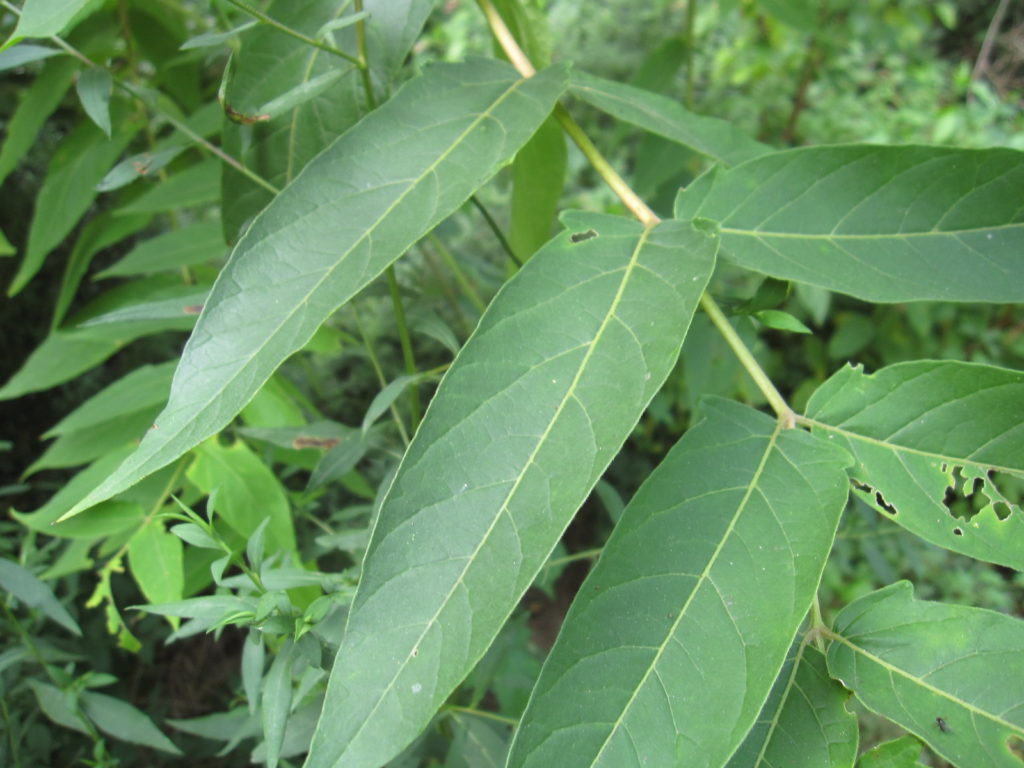 Leaflet with single tooth edges
Leaflet with single tooth edges
The outstanding difference from similar looking trees is the single (sometimes double) “tooth” at the base on the otherwise smooth margin of the leaflets. Black walnut bark is deeply ridged and the leaflets of both black walnuts and sumac trees have serrated edges.
The tree-of-heaven is dioecious — meaning trees are either male or female. Annually, the females can produce 300,000 or more wind-dispersed seeds, which deposit on open ground, and may germinate by the hundreds or thousands in large patches for great distances downwind of the mother tree.
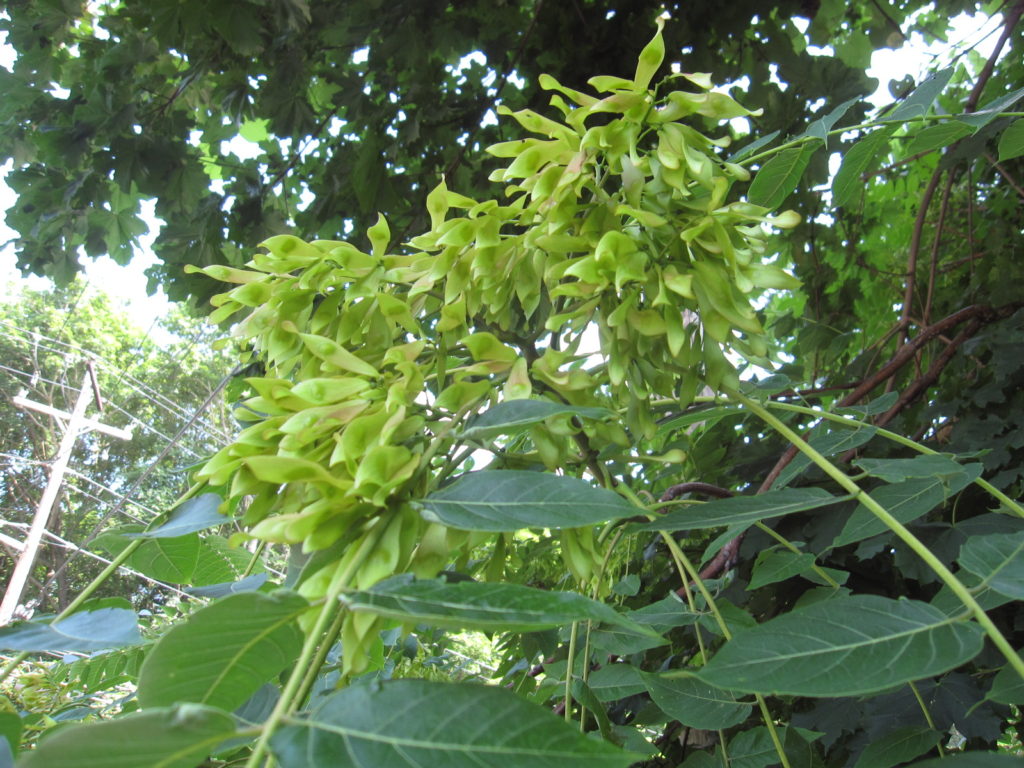 Tree-of Heaven seed pods in late summer
Tree-of Heaven seed pods in late summer
The female can be recognized by the feathery-looking seed stems that remain at the top of the tree through the fall, winter, and early spring after the oblong twisted seed pods (samaras) have dropped.
 Stand of germinating seeds with their first 2 round leaves (cotyledons)
Stand of germinating seeds with their first 2 round leaves (cotyledons)
Seedlings germinate from seeds, deposited by wind dispersal, and can be recognized by two very round leaves along with more mature leaves that begin to resemble the final leaflets. A quick and easy way to clear a large stand of seedlings is to use a squeegee on a pole to draw out and remove the plants with their small roots, or smother with black plastic sheeting for six weeks during mid summer heat.
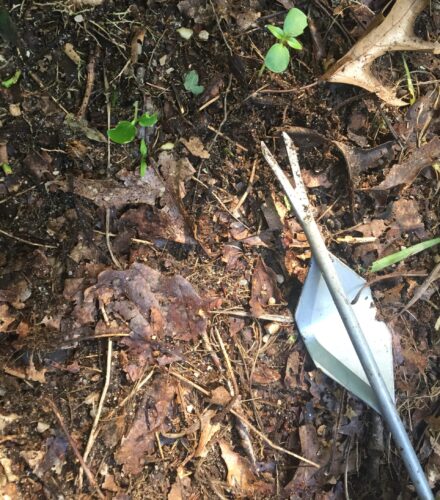
Weeding Tool: If the squeegee is not appropriate for the situation, pop out the seedlings with a common hand weeder while the ground is damp to remove the roots — including the fine hairs at the root tips. Just poke the forked end of a weeding tool at a 45-degree angle into the ground, about two inches from the seedlings to get deep enough beneath the plants to pop it out.
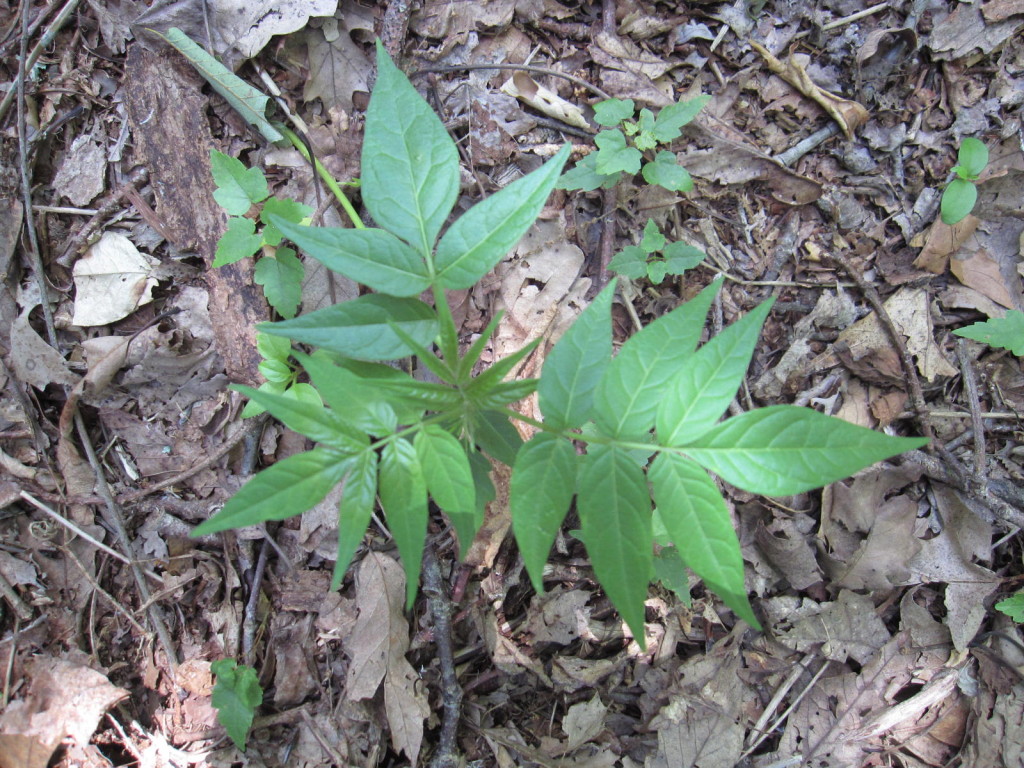 Tree-of-Heaven seeding with opposite leaflets in June
Tree-of-Heaven seeding with opposite leaflets in June
As the tree-of-heaven seedlings continue to grow they can be easily pulled out of the ground by hand or with the help of large household or linesman pliers to grip the stem. All parts of the root/rhizome must be removed since anything left in the ground will resprout. Bag and discard.
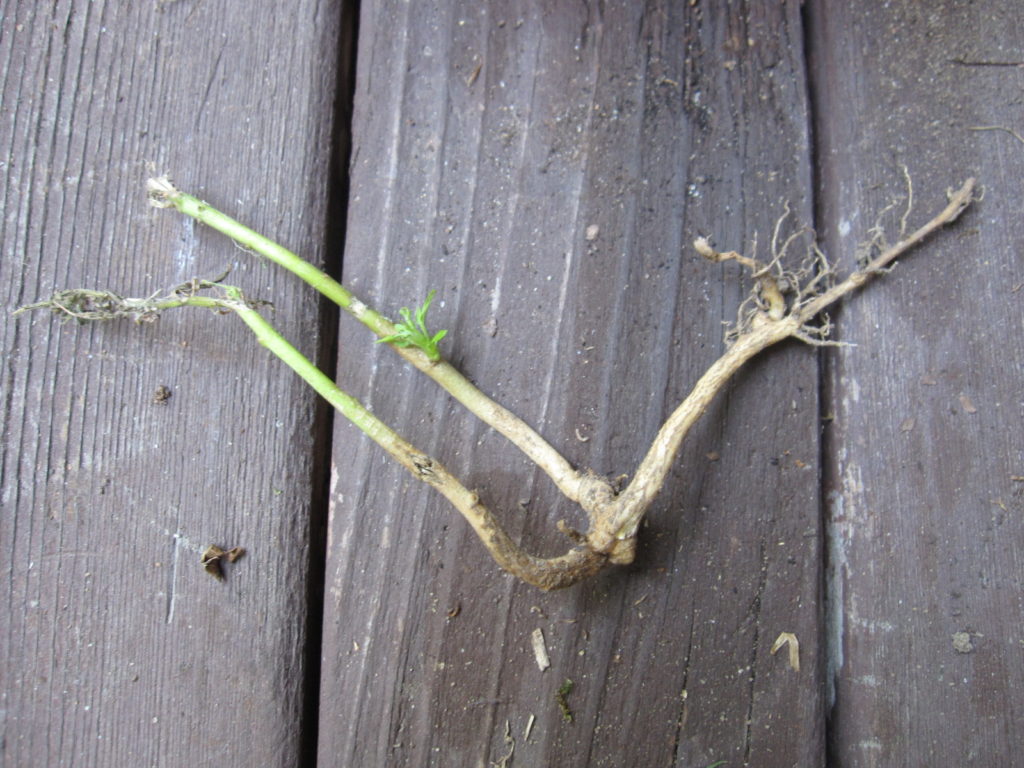 Tree-of-Heaven rhizome with 2 suckers
Tree-of-Heaven rhizome with 2 suckers
Root suckers of tree-of-heaven appear similar to seedlings but with thicker stems. Suckers are connected to pre-existing trees by their their rhizomes or lateral roots that may regrow in clusters, and must be dug up. However, Ailanthus web worm is a native biological control that often eradicates these small shoots.
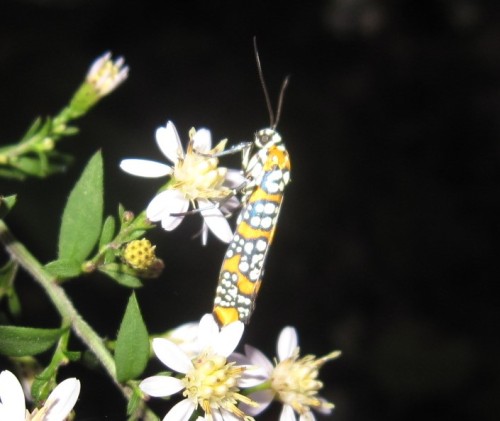 Ailanthus webworm moth in September
Ailanthus webworm moth in September
Good Insects: The small moth, Ailanthus webworm arrives on Long Island from Florida in July through August, and its larvae can be found nesting/eating leaves of its host tree-of-heaven. To help spread the webworms that slow the spread of its host tree, pull out dying seedlings along with their attached larvae, and place them against nearby shoots. The caterpillars should move to the new seedlings and continue feeding. Monitor the progress of the larvae as they morph into pupae. The pupae will not survive Long Island’s winters but, who knows, they may evolve to overwinter someday.
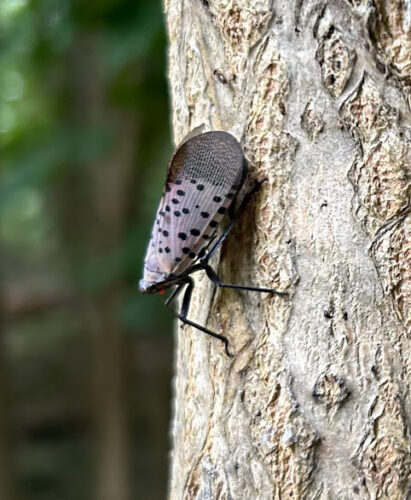
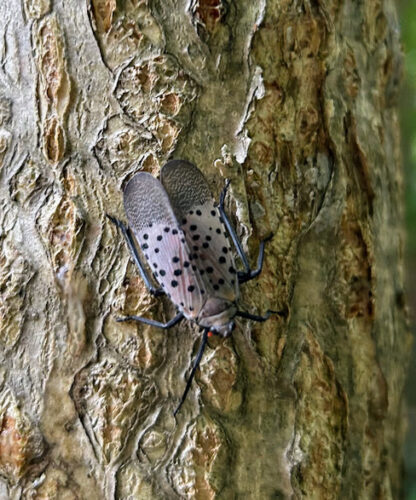
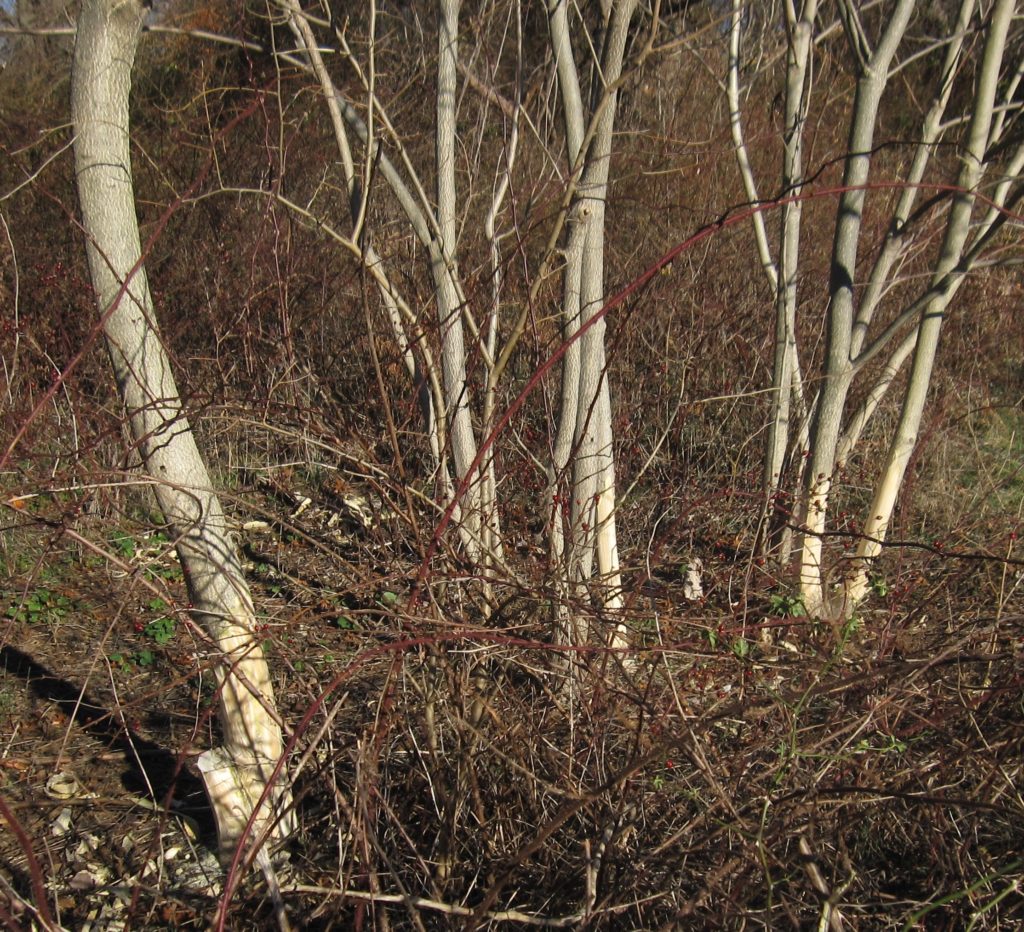 Tree-of-heaven debarked saplings
Tree-of-heaven debarked saplings
Debarking: Saplings and larger trees may be killed down to the root — best done in mid-spring — by a very reliable method: debarking the stem or trunk with a 5 inch draw knife. This method insures that the roots eventually die along with the trees to limit viable suckers from emerging.
Wearing gloves (the sap is known to be toxic), and with the back of one’s underarm wrapped around the tree, lean down, and starting from the ground with the draw knife, shave from the ground upward to between 18 and 24 inches, removing only the rough, fibrous outer and inner bark to the very smooth, slippery inner surface. Use a wood chisel and hammer to remove any missed bark. Often the bark will rip or peel down to the root. Pealing reveals the sweet spot (white and viscous) between the bark and the inner hardwood.
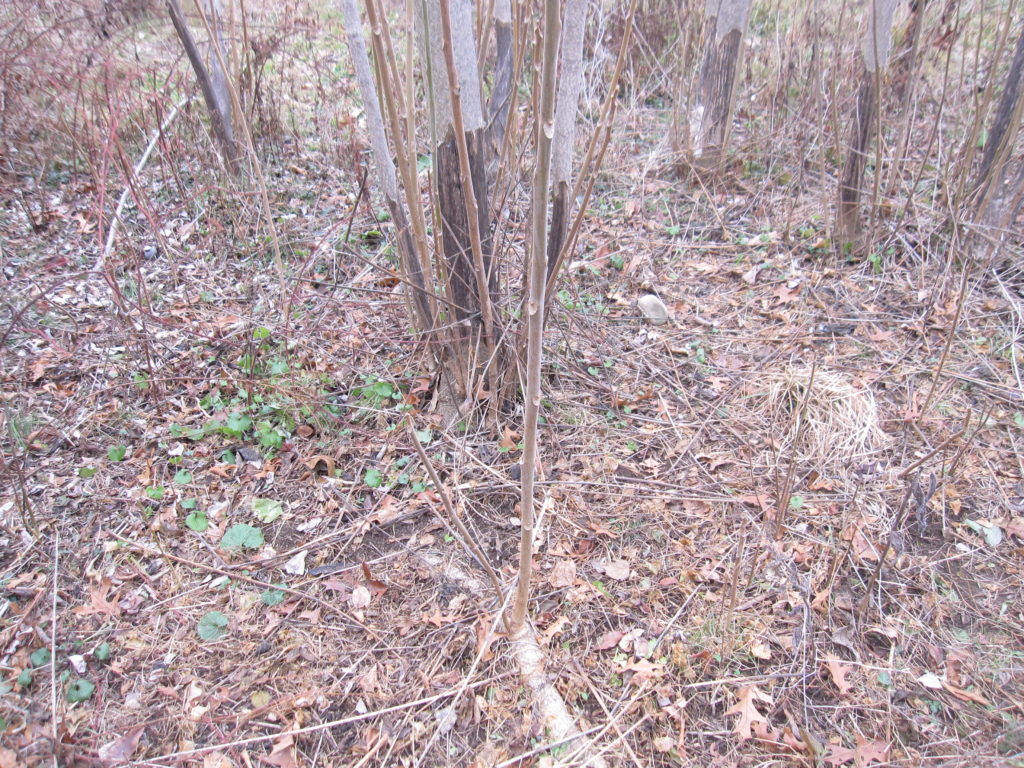 Tree-of-heaven sucker with exposed lateral root
Tree-of-heaven sucker with exposed lateral root
Removing the two outer layers of bark without touching the inner wood where the xylem channels flow, shuts down the outer phloem channels, depriving the roots of nourishment. Because suckers will grow in any space that is not properly debarked, monitor and remove any that may grow on the dying tree.
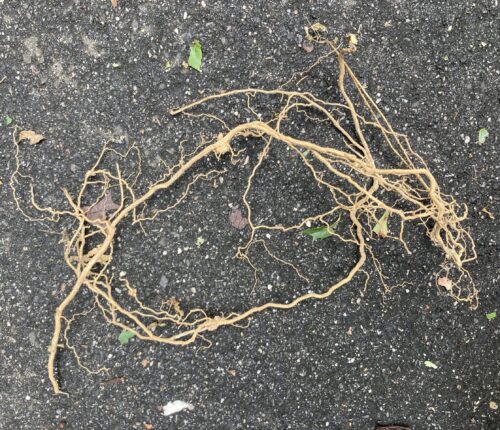 10 Small Suckers were Removed from this 6′ Root
10 Small Suckers were Removed from this 6′ Root
Suckers that may occur generally snap off the tree or pull easily from beneath the ground as the tree and roots die. We allowed the dying trees to desiccate until they dropped with a good push. While a small, dead tree may not do much harm when it falls, larger trees could crush a fence, other trees, or even a dwelling. In such a case, hire a professional arborist experienced with removing large, dead trees.
 Brush pile of debarked saplings
Brush pile of debarked saplings
Every time suckers are removed the root reserves weaken. A year or more later, small saplings, shoots, and desiccated roots should easily pull out or be snapped off. We used a weed wrench on larger plants, during the spring/early summer. If any suckers are firmly attached in the ground they are likely to be viable. Plan on debarking them in mid-spring, or leave them in place if they are hosting Ailanthus webworms.
 Successful results without suckers two years after mid-spring debarking
Successful results without suckers two years after mid-spring debarking
Our Experience: We mistakenly debarked one hundred saplings at Carpenter Farm Park in December* 2015, removed suckers during the summer of 2016, snapped off the dead trees and again uprooted more suckers and seedlings in April and August 2017. Larger trees took several years to die. Our lesson: winter debarking results in numerous suckers.
*Note: Our timing to debark in December appears to be the reason for the large volume of suckers that grew after debarking. We’ve had better results in April/May. According to the U.S. Forest Service, Tree-of-Heaven is most vulnerable early in the growing season just after rapid tissue growth has depleted carbohydrate reserves. Also, the bark is “loose” in spring and early summer when the cambium is active, making it easier to peel.
(One thing we failed to account for was the newly opened canopy, which allowed the ample seed bank to sprout a dense number of both native and invasive plants. The high rate of invasives growth and of Ailanthus suckers could also be an anomaly due to the unusual hot and wet weather we had in May 2017.)
